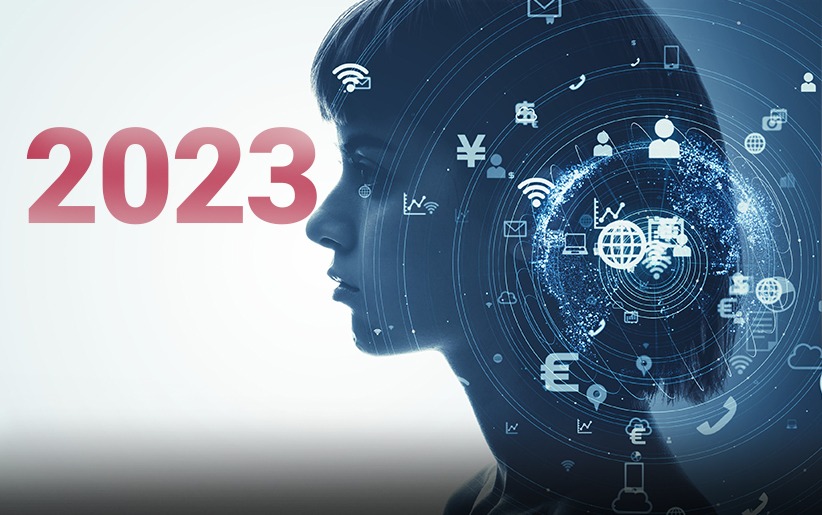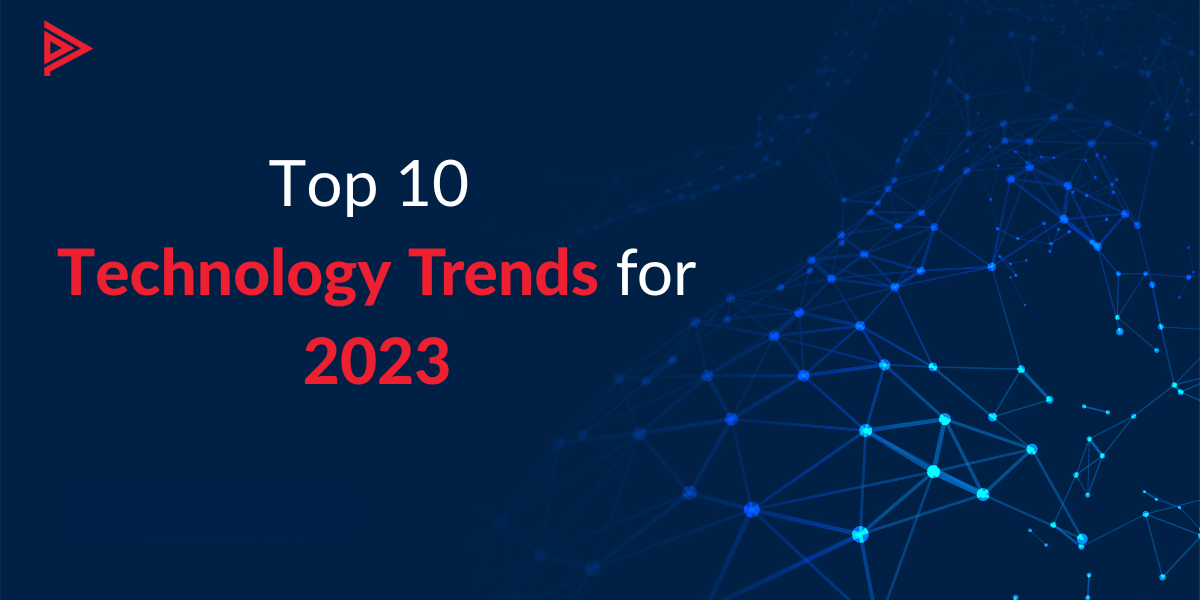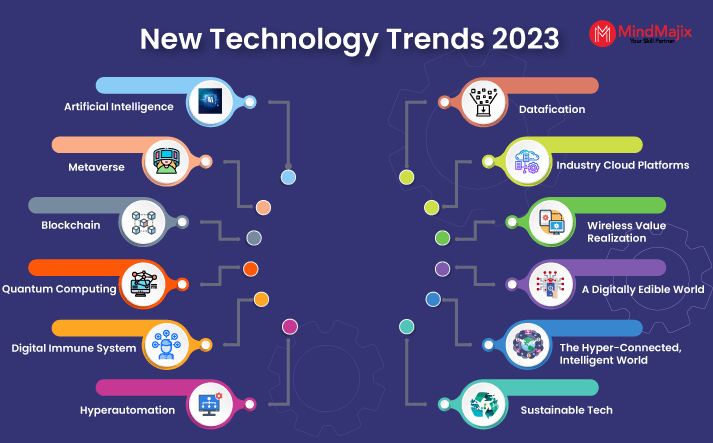Top 10 Technology Trends In 2023
Top 10 Technology Trends In 2023
Here, we’ve compiled an extensive list of the top 10 Technology Trends that are going to shape the technological landscape across the world:
1. Robotics Adoption Trends
Essentially, robotics applications are eliminating long-lasting limits of what individuals can do. Service providers are the leaders in robotic task automation, allowing employees to pay attention to improving the client experience. Hospitality business players are setting up robots to make room deliveries to customers in resorts and hotels.
As robotic technology keeps evolving, robots of any form, size, or function are designed to make a living better and highly convenient for the existing and new generations. These days, robots of every type are being made to overcome all human limitations, reduce the workload, and enable managers and staff to invest more time in main business tasks. With an increasing scale and boosting functionality, a global robotics technological mass market will keep expanding and further impact many people’s lives.
2. IoT Connectivity Trends
Many people use the Internet of Things (IoT) daily. According to the experts, by 2023, the number of connected IoT devices globally will be more than 25 million. By taking internet connectivity to more devices and everyday ordinary electronic gadgets, IoT provides many advantages like machine-to-machine communication and interaction, control, automation of regular tasks, monitoring, time and money savings, competence, and a better quality of life.
Because of IoT’s intelligent, analytical problem-solving and suggestions, consumers will benefit from more experiences from the services and products they purchase. As the international market keeps overpowering with innovative, IoT-connected products, businesses appear to be highly empowered to raise value creation to new heights for the modern customer.
3. Augmented Analytics Trends
Augmented analytics is another notable aspect of digital trends. This fantastic technology has effectively evolved business analytics by utilizing robust machine learning and incorporating analytical competencies such as process mining, data science, data preparation, data management, business process management, etc. Also, our know-how of the reasons why we utilize business intelligence will possibly change.
With the upsurge of augmented analytics, we’ve come beyond the time of laid-back reporting about the past with the rise of taking dynamic live updates and an evidence-based prediction on what will happen in the target market. As the technology evolves, so will self-learning platforms such as augmented analytics as a large amount of information comes our way.
4. AI & Cognitive Transformation Trends
Approximately 85% of businesses are assessing or utilizing AI in production already. CIOs think AI can evolve the organization to make it client-driven, highly adaptive, and can create and share business intelligence more quickly. Moreover, AI is expected to significantly impact industrial performance by mining data to assist in forecasting customer behavior, improving machine learning, and figuring out environmental patterns.
In the year 2020, AI utilization will keep expanding across industries mainly because of the enormous benefits it brings to the table. Such advantages involve decision-making, process efficiency, and highly effective service and product development.
According to another study, enterprises further enhanced their AI deployment because of its benefits to certain corporate functions, like managing the personalization requirements of data analytics and customers. A similar study expects that by 2023, more than 20 million new AI jobs will be readily available.
5. Winning Technology Trends
Most prominent technologies such as augmented reality, virtual reality, and mixed reality, along with communications software, will evolve how users communicate and view the world, thus resulting in a novel winning experience. A significant number of companies deploy emerging technologies for their customer as well as for operational use.
Conversational solutions are commonly expected to integrate more sensory means that will allow emotion detection based on the user’s facial expressions. In contrast, customer interactions will be highly conversational, which involves more human touch.
With the assistance of these technologies, yesterday’s science fiction has become a reality. And businesses are more excited to understand its existing and new applications.
6. API-Driven Productivity Trends
The development of APIs can be related to the SaaS market development. While SaaS applications became the deployment of business sizes, the APIs market likewise exploded. A fundamental element of software development, APIs have turned into an essential aspect of business technology. The broader practice of tapping third-party API providers has provided rise to many problems.
According to the study, 83% of businesses found API-based interactions as crucial aspects of their business tactic, notably because of their growing cloud adoption and digital transformation programs.
Specifically, now that smartphones and other intelligent devices are commonly used, APIs have become a crucial technology investment for SMBs, especially for developing mobile apps and sites. Also, APIs enable remote workers to easily access related business data generally placed in highly secure storage.
7. Smart Space Trends
A bright space is now commonly utilized by businesses around the industries. By giving a realistic and secure digital environment where systems and ap
s can smoothly interact, companies can take benefit of such effective ecosystems to back up their operations, increase collaboration among remote workers, and boost their marketing-related activities.
Bright spaces are making way for exceptional collaboration among mature and popular technologies. With innovative spaces incorporating AI-powered technologies, blockchain, digital twins, and edge computing have become simple and quite efficient for business and industrial applications. Bright areas primarily build up as other technologies, which are further integrated from their silos to cooperate as one unit to produce an environment of fruitful collaboration.
8. Customer Support Chatbot Trends
Chatbots have been advancing business-customer interaction for many years. For 2020 and the upcoming years, chatbots for consumer support are predicted to take center stage as many businesses are deploying them on their sites to improve consumer engagement. They’re not simply available 24/7 but can likewise smoothly interact with each site visitor without waiting anymore.
Any special live chat software integrated with a chatbot will enable you to instantly engage with potential and current customers. For example, they can get the data they want, from product inquiries to costing, to technical rules and troubleshooting advice, while just looking at your site. With a great customer experience – without waiting long for a rep’s delayed action – these chatbots virtually changed the customer support process into a better version.
In industries that organize many human interactions, such as banking and health care, 75-90% of queries are hoped to be managed by chatbots from 2019 to 2023.
9. Live Chat Software
Zendesk offers you a bot that can enable you to answer customer questions. New features involve conversion tracking, macros, group rules, and multi-brand support.
LiveChat has a cohesive chatbot that can help you decrease customer support volume. This enables you to reach maximum customers proactively.
Freshchat is made for supporting teams of every size? It has a bot that enables you to collect consumer information and is always there when your agents are offline.
Salesforce Live Agent and Einstein chatbot can help live human agents address repetitive customer queries. The live chat involves multilingual agent support, queue monitoring, and IM session metrics.
Zoho Sales IQ comprises a bot-building module that lets you personalize your chatbots. The app has lead generation, geolocation tracking, and actionable insights.
10. Blockchain Trends
Blockchain is an advanced type of distributed ledger. It allows companies to monitor a transaction and do business with unconfirmed parties without help from financial institutions such as banks. This new ability significantly reduces business conflicts and offers advantages such as append-only transparency, data structure, security, immutability, and decentralization.
Even though primarily beginning its application in financial transactions, blockchains are widely used in different industries and sectors, such as manufacturing, supply chain, healthcare, and public service. This technology allows reduced transaction settlement durations and Dec, and. Also, it has encouraged a broad spectrum of blockchain-driven applications that utilize several components and benefits of blockchain.
Well-organized blockchains are already delivering multiple advantages. Businesses are expected to begin studying blockchain technology, predicted to produce essential business opportunities worldwide. Blockchain technology is expected to boom to over US$23.3 billion by 2023.



